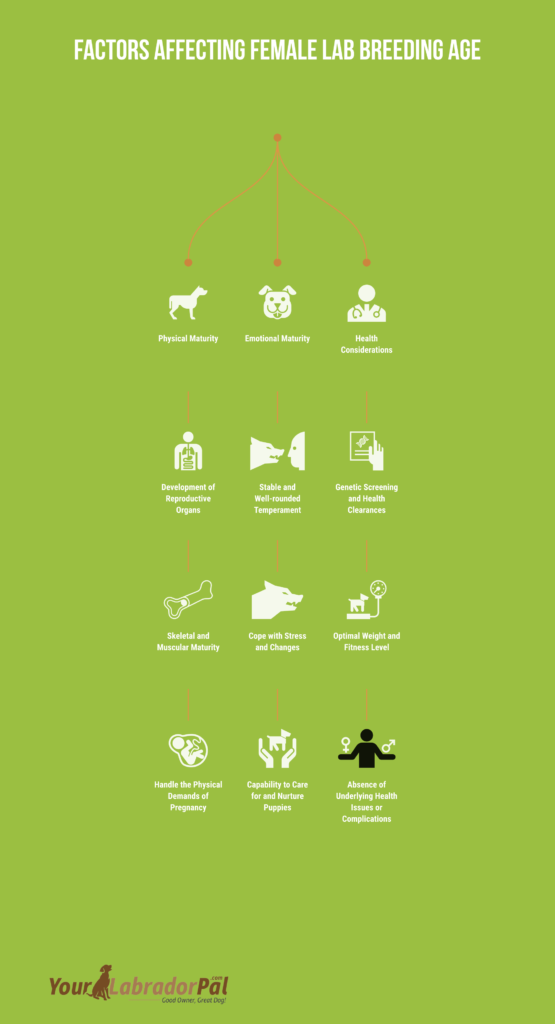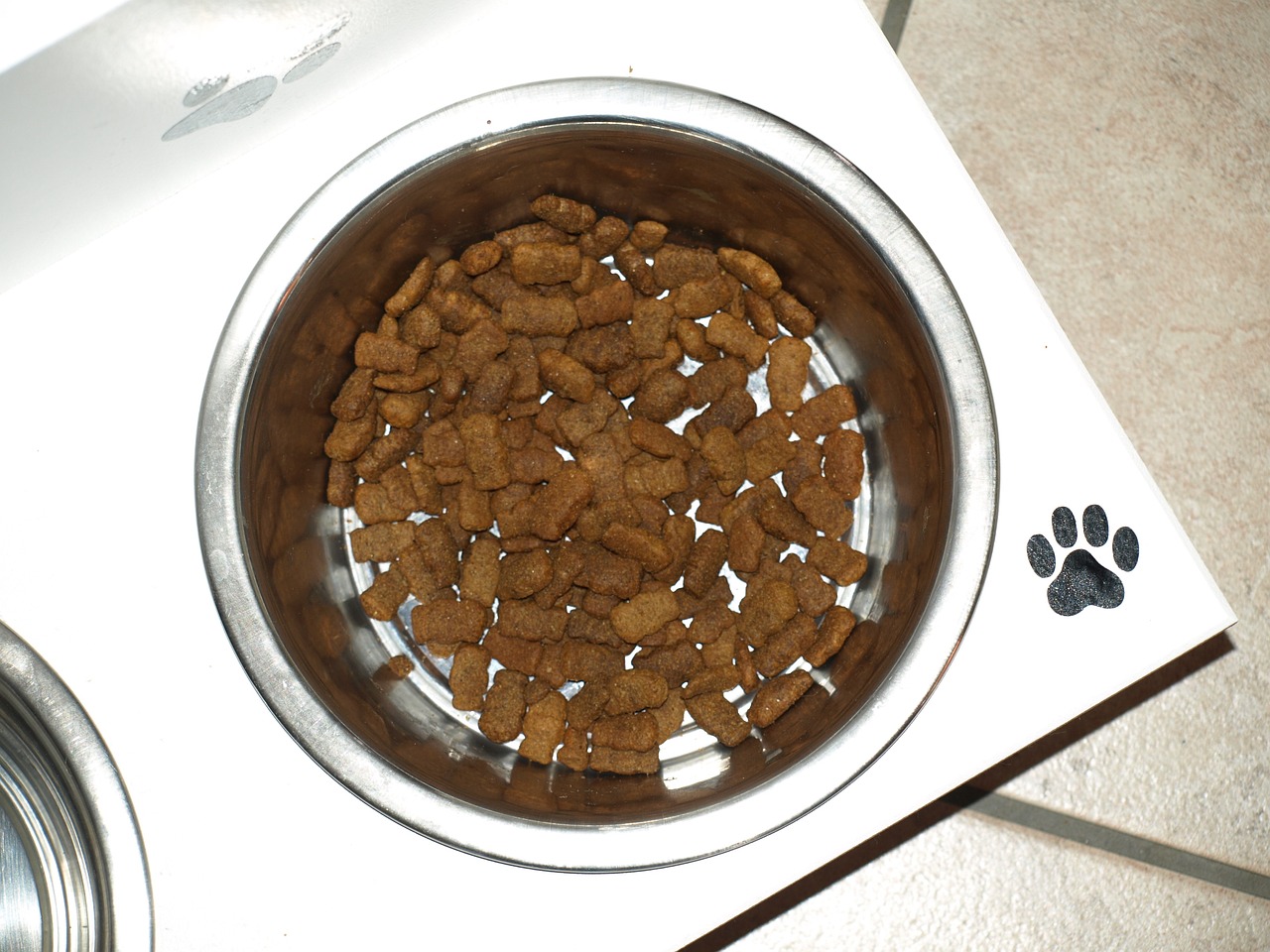Perfect Age for Breeding: At What Age Can A Female Labrador Mate
As a Labrador owner, you might ask, “At what age can a female Labrador mate?” It is a crucial question for anyone considering breeding their beloved pet. Responsible breeding is not only important for the health and well-being of your Labrador, but it also helps ensure the welfare of future puppies. In this blog post, we will focus on the importance of understanding the best age to breed a female Labrador and the factors that contribute to making an informed decision.
Responsible breeding is essential to maintaining healthy bloodlines, minimizing genetic issues, and ensuring your Labrador Retriever breed has a safe and comfortable pregnancy. One of the key aspects of responsible breeding is determining the optimal mating age for your female Labrador. It will help prevent potential complications during pregnancy and give your dog the best chance at a successful and happy motherhood experience.
So, let’s dive in and explore the world of Labrador breeding and the ideal age for your female Labrador to become a proud mom!
Understanding Labrador Growth and Development Stages
Before we delve into the ideal age for breeding a female Labrador, we must clearly understand their growth and development stages. It will help you better comprehend the physical and emotional changes your Labrador goes through as she matures.
🐶The Puppy Stage (0-6 months): A Time of Rapid Growth and Learning
Rapid Growth and Physical Development
During the first six months of a Labrador’s life, they experience rapid growth and physical development. At birth, a Labrador puppy typically weighs around 1 pound. By the time she reaches six months, her weight can increase to 50 pounds or more. Significant changes in her body mark this period, such as developing stronger bones, muscles, and teeth.
If your Labrador puppy is fully grown, you’ll notice that her limbs become longer and her body more proportional. It’s crucial to provide her with proper nutrition during this stage to support healthy development and avoid potential health issues later in life. For example, feeding your puppy a balanced diet specifically designed for large breed puppies can help ensure she receives the right nutrients in the correct proportions.
Introduction to Socialization and Basic Training
The puppy stage is also perfect for introducing Labrador Retrievers to socialization and basic training. Exposing your puppy to various environments, people, and other animals is essential for building her confidence and ensuring she develops into a well-adjusted adult dog.
Start by taking your Labrador to puppy socialization classes, where she can interact with other puppies and learn essential skills like bite inhibition. Introduce her to different sights, sounds, and smells in controlled environments to help her become more comfortable with new experiences.
Basic obedience training should also begin during the puppy stage, usually around 8-12 weeks. Teaching your Labrador simple commands like “sit,” “stay,” and “come” will not only strengthen your bond with her but also help establish a foundation for more advanced training later on. Remember, positive reinforcement and consistency are key when training your puppy. Reward her with praise and treats when she follows your commands, and be patient as she learns.
🐶Adolescence stage (6-18 months): A Period of Discovery and Refinement
Continued Growth and Development
During adolescence, your Labrador will continue to grow, but at a slower pace compared to the rapid growth experienced during the puppy stage. By the time she reaches 18 months, she will likely have reached her full adult size. However, it’s important to remember that each dog is different. Some may continue to fill out and develop muscle until they are around two years old.
Maintaining a balanced diet tailored to your Labrador’s needs is still crucial throughout this stage. Take note of her weight and activity levels, and adjust her food intake accordingly. Regular vet check-ups can help monitor her growth and ensure she remains healthy throughout adolescence.
Increased Energy Levels and Independence
As your Labrador grows into an adolescent, you’ll notice a significant increase in her energy levels and independence. She may become more curious about her surroundings and display a greater desire to explore. It is a natural part of her development but can sometimes lead to unwanted behaviors, such as digging or chewing on inappropriate items.
To channel your Labrador’s energy in a positive direction, provide her with plenty of physical and mental stimulation. Engage her in daily exercises, such as walks, fetch, or swimming. Interactive toys and puzzle feeders can also help keep her mind occupied and prevent boredom.
Refinement of Social Skills and Training
The adolescence stage is an important time to reinforce and refine the social skills and training your Labrador learned as a puppy. She may test boundaries and exhibit stubbornness, but remaining patient and consistent with your training methods is essential.
Continue attending obedience classes and practice commands daily to reinforce good behavior. Socialization should also be ongoing, so regularly expose your Labrador to new experiences and environments. It can include trips to the dog park, walks in different neighborhoods, or even enrolling her in a doggy daycare.
🐶Adulthood Stage (18 months onwards): A Time of Maturity and Stability
Slower Growth Rate and Physical Maturity
Once your Labrador reaches adulthood, her growth rate will slow down significantly, and she will have achieved most of her physical development. While she may continue to fill out and develop muscle until around two years old, her overall size will remain fairly consistent throughout her adult life.
At this stage, it’s important to monitor her weight and adjust her diet to maintain a healthy body condition. Regular exercise and mental stimulation are also crucial to ensure she remains physically fit and mentally sharp.
Stabilized Temperament and Behavior
As an adult, your Labrador’s temperament and behavior will become more stable and predictable compared to her adolescent years. She will likely be calmer, more focused, and less prone to testing boundaries. It is an ideal time to engage in advanced dog training or consider enrolling her in dog sports like agility or dock diving.
Despite her increased maturity, it’s essential to continue reinforcing good behavior and providing consistent guidance. Regular socialization and exposure to new experiences will help ensure she remains a well-rounded and adaptable companion.
Ideal Stage for Breeding
The adulthood stage is the best time for breeding female dogs. By this age, she has reached physical and emotional maturity, reducing the risks associated with pregnancy and ensuring she is better prepared to care for her puppies.
Before you breed Labrador Retrievers, consult your veterinarian to discuss potential health risks and necessary screenings. It’s also essential to research and select an appropriate mate, considering factors like temperament, genetic health, and dog breeding standards.
At What Age Can A Female Labrador Mate?
Now that we have a thorough understanding of the growth and development stages of Labradors, it’s time to address the main question: At what age can a female Labrador mate?
💕Recommended Age Range (2-4 years)
Most experts agree that the ideal age range for breeding a female Labrador is between 18 to 24 months. By this age, your dog has reached both physical and emotional maturity, reducing potential complications during pregnancy and ensuring she is better equipped to care for her puppies.
It’s important to consult with your veterinarian before breeding your Labrador, as they can provide guidance on any necessary health tests and screenings and discuss any potential risks associated with your dog’s specific situation.
💕Benefits of Waiting
There are several benefits to waiting until your female Labrador is within the recommended age range to start breeding. These include:
- Physical maturity: Waiting ensures that your dog’s body is fully developed and able to handle the physical demands of pregnancy and nursing.
- Emotional maturity: A more mature dog should handle the stress and responsibilities of caring for a litter of puppies.
- Healthier puppies: Breeding a healthy, mature female Labrador increases the likelihood of producing strong, healthy puppies with fewer genetic issues.
- Established temperament: By the time your dog is 2-4 years old, her temperament and behavior are more predictable, making it easier to select an appropriate mate and anticipate the temperament of the puppies.
💕Risks of Breeding Too Early or Too Late
Breeding your female Labrador too early or too late can pose various risks to the mother and her puppies. Some of these risks include:
- Breeding too early: Breeding a Labrador before she reaches physical and emotional maturity can result in complications during pregnancy, a higher risk of birth defects, and difficulty caring for her puppies.
- Breeding too late: As your Labrador ages, her fertility decreases, and the likelihood of pregnancy complications increases. Additionally, older dogs may have difficulty recovering from pregnancy and nursing.
Factors Affecting The Ideal Breeding Age For Female Labradors
While we have established the recommended age range for breeding a female Labrador, it’s important to recognize that each dog is unique, and various factors can influence the ideal breed dog age.
👉🏻Physical maturity
Development of Reproductive Organs
One of the key factors to consider when determining the ideal dog breed age for your female Labrador is the development of her reproductive organs. Although a female dog may experience her first heat cycle as early as six months old, this does not mean she is ready for breeding. Her reproductive system is still developing during her early stages of life, and breeding too soon can pose risks to both her and her puppies.
Waiting until your Labrador has experienced at least two to three heat cycles will help ensure a fully developed and properly functioning reproductive organ. It will reduce the likelihood of complications during pregnancy and improve the chances of successful breeding.
Skeletal and Muscular Maturity
Another important factor to consider is your Labrador’s skeletal and muscular maturity. As previously discussed, Labradors continue to grow and develop until they are two years old. Breeding before their bones and muscles are fully developed can put additional strain on their body, increasing the risk of complications during pregnancy and whelping.
By waiting until your Labrador has reached full skeletal and muscular maturity, you’ll help ensure she is better able to handle the physical demands of pregnancy and provide proper care for her puppies.
Ability to Handle the Physical Demands of Pregnancy and Whelping
Pregnancy and whelping can be physically demanding for a female Labrador, so ensuring she is ready for these challenges is crucial. A physically mature dog will have a better chance of handling the demands of pregnancy and recovering more quickly after giving birth.
Before breeding your Labrador, consult your veterinarian to assess her overall health and fitness. They can help you determine whether she is ready for the physical demands of pregnancy and provide guidance on any necessary precautions to take during this time.
👉🏻Emotional maturity
Stable and Well-rounded Temperament
A Labrador with a stable and well-rounded temperament is better suited to handle the demands of motherhood. By waiting until your dog has reached emotional maturity, you’ll ensure she has developed a balanced personality and is less likely to exhibit undesirable behaviors, such as anxiety or aggression, during pregnancy and whelping.
Continuing to socialize and expose your Labrador to new experiences throughout her life can help maintain a stable temperament and ensure she remains adaptable and well-adjusted.
Ability to Cope with Stress and Changes Associated with Pregnancy
Pregnancy can bring about significant changes in a dog’s body and environment, which can be stressful for some dogs. A female Labrador who has reached emotional maturity will be better equipped to cope with the stress and changes associated with pregnancy, reducing the risk of complications.
Help prepare your dog for the challenges of pregnancy by establishing a strong bond and providing consistent guidance throughout her life. It will help build trust and ensure she feels secure and supported during this critical time.
Capability to Care for and Nurture Puppies
A crucial aspect of emotional maturity is a dog’s ability to care for and nurture her puppies. A female dog who has not yet reached emotional maturity may struggle to properly care for her puppies, potentially leading to health issues or developmental problems for the litter.
By waiting until your Labrador is emotionally mature, you’ll increase the likelihood that she will be a nurturing and attentive mother, able to meet her puppies’ needs and ensure their well-being.
👉🏻Health considerations
Genetic Screening and Health Clearances
Before breeding your female dogs, it’s essential to obtain genetic screening and health clearances for both her and the prospective sire. These tests can help identify potential genetic issues or health problems that could be passed on to the puppies, allowing you to make informed breeding decisions.
Common health clearances for Labradors include hip and elbow dysplasia evaluations, eye examinations, and testing for genetic conditions such as progressive retinal atrophy (PRA) and exercise-induced collapse (EIC). Consult your veterinarian to determine which tests are necessary for your dog and her prospective mate.
Optimal Weight and Fitness Level
A female Labrador at an optimal weight and fitness level will be better prepared to handle the physical demands of pregnancy and whelping. Overweight or underweight dogs may face increased risks of complications during pregnancy, as well as difficulties caring for and nursing their puppies.
Monitor your dog’s weight and body condition regularly, adjusting her diet and exercise routine to maintain optimal health. Your veterinarian can guide the appropriate weight and fitness level for your Labrador and recommend a suitable diet and exercise plan.
Absence of Underlying Health Issues or Complications
Before breeding your female Labrador, ensuring she has no underlying health issues or complications that could affect her ability to carry and care for her puppies is crucial. Schedule a comprehensive veterinary examination to assess her health and identify potential concerns.
If your veterinarian discovers any health issues, discuss the possible implications for breeding and whether a proceeding is advisable. In some cases, treating or managing the condition may be necessary before considering breeding.
Preparing Your Female Labrador For Breeding
Once you have determined that your female Labrador is at the ideal age and in optimal health for breeding, it’s time to start preparing her for this exciting journey. This section will discuss essential steps to take when getting your Labrador ready for breeding, including health tests and screenings, nutrition and exercise, and choosing the right mate.
✅Health Tests and Screenings
Obtaining the necessary health tests and screenings for your female Labrador and her prospective mate is crucial before breeding. These tests can help identify potential genetic issues or health problems that could be passed on to the puppies, allowing you to make informed breeding decisions.
Consult your veterinarian to determine which tests are necessary for your dog and her prospective mate. Common health clearances for Labradors include hip and elbow dysplasia evaluations, eye examinations, and testing for genetic conditions such as progressive retinal atrophy (PRA) and exercise-induced collapse (EIC).
✅Nutrition and Exercise
Maintaining optimal nutrition and exercise for your female Labrador is essential in the months leading up to breeding. A dog at an ideal weight and fitness level will be better prepared to handle the physical demands of pregnancy and whelping.
Work with your veterinarian to develop a tailored diet and exercise plan that meets your Labrador’s needs. Remember that her nutritional requirements may change during pregnancy, so closely monitoring her weight and body condition is important, making adjustments as needed.
✅Choosing the Right Mate
Selecting the right mate for your female Labrador is a critical step in breeding. When choosing a prospective sire, consider temperament, genetic health, and breed standards. It’s also essential to ensure he has undergone the necessary health tests and screenings to minimize the risk of passing on genetic issues or health problems to the puppies.
Research potential mates, seek advice from experienced breeders, and consult with your veterinarian. Choosing a suitable mate will help increase the likelihood of producing healthy, well-rounded puppies that inherit the best traits from both parents.
Responsible Breeding Practices
Breeding your female Labrador is a significant responsibility, and it’s essential to prioritize the well-being of the mother and her puppies throughout the process.
📌Ethical Considerations
When deciding to breed your female Labrador, it’s crucial to consider the ethical implications of your decision. Responsible breeding involves more than just producing puppies; it requires a commitment to improving the breed and ensuring the welfare of all dogs involved.
Some ethical considerations to keep in mind include:
- Only breeding dogs meet breed standards and obtain the necessary health clearances.
- Ensuring you have the time, resources, and knowledge to care for a pregnant dog and her puppies.
- Carefully screening potential puppy buyers to ensure they can provide loving, responsible homes.
- Providing ongoing support and guidance to puppy buyers throughout the dog’s life.
📌Breeding Frequency and Litter Size
When breeding your female Labrador, it’s essential to consider how often she should be bred and the appropriate litter size. Most experts recommend allowing a female dog to have no more than one litter per year, giving her body ample time to recover between pregnancies.
Additionally, it’s important to recognize that litter size can vary based on factors such as the age and overall health of the mother. Work closely with your veterinarian to determine the appropriate breeding frequency and litter size for your specific dog, prioritizing her health and well-being at all times.
📌Post-pregnancy Care
Providing proper post-pregnancy care for your female Labrador is critical to responsible breeding. After giving birth, your dog will require additional support and monitoring to ensure she recovers fully and can care for her puppies effectively.
Some essential post-pregnancy care guidelines include:
- Monitoring your dog’s health closely, watching for any signs of complications or illness.
- Providing a comfortable, clean environment for the mother and her puppies.
- Ensuring your dog receives proper nutrition to support her recovery and nursing needs.
- Regularly check the puppies’ growth and development and seek veterinary care if any issues arise.
Frequently Asked Questions
Q: Can I breed my female Labrador before she is two years old?
A: We all want to give our pets the best start in life, but we also don’t want to put them in any harm’s way. The general rule is to wait until your Labrador is at least two years old before considering breeding. It allows her body to mature and reduces the risk of health complications. It’s undoubtedly tempting to see those adorable little puppies running around, but it’s worth waiting to ensure the health and well-being of your furry friend.
Q: Is there an upper age limit for breeding a female Labrador?
A: While there isn’t a strict maximum age for Labrador to have puppies, it’s generally recommended not to breed a female Labrador beyond six years. Labradors may face increased health risks during pregnancy and whelping as they age.
Q: How many times can you breed a Labrador?
A: If you’re a proud Labrador owner, you know how much love and attention these fantastic animals need. And if you’re considering breeding your female dog, it’s natural to have some questions. There’s no strict rule regarding how often you should breed your Labrador. It depends on several variables, including the Labrador breeding cycle, the pup’s age, health, ovulation cycle, and lifestyle. To ensure a happy and healthy litter, do your research, consult a trusted veterinarian, and consider all variables before deciding.
Final Words
Determining the perfect age for breeding Labrador female dogs involves carefully considering various factors, including physical and emotional maturity, health, and preparedness. By waiting until your dog is between 2 and 4 years old and ensuring she is in optimal health, you’ll contribute to a successful breeding experience and support the well-being of your dog and her future puppies.
Remember, responsible breeding practices are essential in maintaining the breed’s integrity and promoting the health and happiness of all dogs involved. From ethical considerations to post-pregnancy care, every step of the breeding process should prioritize the welfare of your beloved Labrador and her puppies.
As you embark on this exciting journey, we encourage you to continue learning and seeking guidance from experienced breeders, veterinarians, and fellow Labrador enthusiasts. And if you have any thoughts, questions, or experiences to share, please feel free to comment below.











